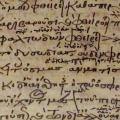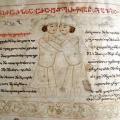318. Oliver Primavesi on Greek Manuscripts
Oliver Primavesi tells us how Greek manuscripts are used to establish the text of authors like Aristotle.
Prof Primavesi runs the Munich School of Ancient Philosophy together with Christof Rapp and Peter Adamson.
Themes:
• O. Primavesi, Die Aristotelische Topik: Ein Interpretationsmodell und seine Erprobung am Beispiel von Topik B (München: 1996).
• O. Primavesi, Empedoklesstudien: Ein unveröffentlichter Papyrus und die indirekte Überlieferung (Frankfurt: 1997).
• A. Martin and O. Primavesi, L'Empédocle de Strasbourg, Introduction, Édition et Commentaire (Berlin: 1999).
• O. Primavesi, Empedokles Physika I: Eine Rekonstruktion des zentralen Gedankengangs, (Berlin: 2008).
• O. Primavesi and K. Luchner (eds), The Presocratics from the Latin Middle Ages to Hermann Diels (Stuttgart: 2011).
• J. Mansfeld und O. Primavesi (ed. and trans.), Die Vorsokratiker (Stuttgart: 2011).
• O. Primavesi, “Aristotle, Metaphysics A. A New Critical Edition with Introduction by Oliver Primavesi,” in C. Steel (ed.), Aristotle’s Metaphysics Alpha. Symposium Aristotelicum (Oxford: 2012), 385–516.
• M. Di Giovanni and O. Primavesi, “Who Wrote Alexander’s Commentary on Metaphysics Λ? New Light on the Syro-Arabic Tradition,” in C. Horn (ed.), Aristotle, Metaphysics Lambda - New Essays (Berlin: 2016), 11–66.
• O. Primavesi and C. Rapp, Aristoteles (München: 2016).
• O. Primavesi and K. Corcilius, Aristoteles, Über die Bewegung der Lebewesen – De motu animalium (Hamburg: 2018).







Comments
Not Pluto
Erratum: it was Neptune whose location was calculated and then observed where it was predicted, not Pluto. Sorry about that, astronomy lovers!
HoPWaG volume inclusion
Hey Peter,
Great episode with Oliver Primavesi though it’s now going to require much more effort for me to pompously hold forth based on quoting Aristotle from the random textbook version.
But I mainly wanted to lament that, though it’s completely understandable, it’s a kind of a shame that you can’t include some of the excellent interviews like this in the printed version. True, we can always just refer back to the podcast. But we dinosaurs that have a hard time forcing ourselves to believe or find anything not in a bound volume, have to find something to complain about...
In reply to HoPWaG volume inclusion by Karl Young
Publishing the interviews
Yes, I know what you mean (I'm a bit of a dinosaur myself actually, despite being a podcaster). Maybe I should think of putting together a special volume just with selected episodes at some point....
Dear Peter,
Dear Peter,
it was really interesting to hear that the Greek text of Aristotle's Poetics was improved based on the Arabic translation, given the bad press this translation generally gets (Borges etc.). Where could I read further details on this improvement?
Thank you,
Oliver
In reply to Dear Peter, by Oliver
Poetics
Probably the best thing to look at is the new Taran/Gutas edition which takes account of the Arabic. There is a review here.
I am very excited about the
I am very excited about the impact of new textual discoveries in our days. For example, the modern idea of the western model of state, as developed in the British, American and French revolutions, had been already complete, when Cicero's work "De re publica" had been discovered in 1819, but taken into the discussion of Plato's idea of state, and of the modern state, only in the time of World War I. Another interesting field is getting an ever more deeper look into the very beginnings of philosophy, especially the Pythagoreans and Empedocles in Southern Italy, and their impact on Plato. It is my humble opinion, e.g., that the Unknown Fourth person in Plato'sTimaeus is Empedocles. Which gives the whole dialogue a completely different "drive". I will write on this.
'hip' archetypes
Did I hear this phrase correctly? In any case, can you explain why this stage in the transmission process was given this name, or whatever name it actually has?
In reply to 'hip' archetypes by Steve DS
"Hip"
Great mis-hearing, but no: the term is "hyparchetype" from the prefix hypo-. So this is the original copy that lies behind later copies.
some further questions
1. When did editors begin to construct stemmas for ancient texts, presumably using the principles described about errors being the key to constructing them?
2. It was mentioned that Aristotle's Poetics was translated into Arabic. But, if I remember correctly, it was said in an earlier podcast that the Arabs didn't translate Greek literature like Homer. Presumably they didn't translate tragedians like Sophocles, either. In which case, how much sense could have they made of the Poetics? Can you say something about how Arab scholars used the Poetics? (Maybe you already did.)
3. Oliver says that the watermarks of paper manuscripts help date them. Can you say more about how precisely they can date them? I'd imagine that a given paper mill would use the same watermark for all the years it operated.
In reply to some further questions by Steve DS
Some further answers
Some of that is a bit outside my competence but I'll do my best:
1. I think stemmata codicum start coming in quite late, like 19th century. We don't find this technique among Renaissance scholars for example. Of course, for it to make sense you need to have a pretty comprehensive sense of the whole manuscript tradition so you need a situation where scholars can get around to lots of libraries, access catalogues, etc.
2. Here I can give you a good answer: the Poetics was translated, not because they were interested in Greek poetry but because they were interested in Aristotle. Already in late antiquity the Poetics was considered to be part of the "Organon" i.e. the Aristotelian logical corpus, so it was important for them. They also translated the Rhetoric pretty early. There is not only the translation but also a series of works responding to it, like paraphrase commentaries by Farabi and Ibn Rushd (Averroes).
3. Watermarks: this is the one where I am least sure myself. But I guess you're right in principle that it could narrow it down only to a period and place, rather than, like, a single week in 1434. But I guess that the watermarks vary for each batch of the paper, not only by the paper maker (like, you could imagine that the seal looks slightly different from one batch to the next). In any case if it only gets you to the city and within a few years that is already a lot of information.
In reply to Some further answers by Peter Adamson
Stemmata
Thanks for these helpful answers. This is a great episode for helping to understand the transmission of our texts.
Thinking more about the first issue: Renaissance scholars like Erasmus must have had some sense of the sequence of manuscripts. Didn't he realize that some passages in the Vulgate NT weren't attested in Greek manuscripts, which he knew must be older, or at least, more reliable?
But probably the idea that mistakes are a good way to sequence manuscripts was a later idea. It's a brilliant insight. I'd love to know who came up with it!
In reply to Stemmata by Steve DS
Erasmus and the Vulgate
It's well timed you ask that question because I only just read up on Erasmus and his editorial techniques for the episode on him. The answer is actually no: it did not occur to Renaissance scholars that the Vulgate would reflect readings of a far older, lost Greek manuscript; they just assumed that divergences from the Greek manuscripts they had were mistakes. Nowadays scholars are more clued up and have even done things like retrotranslating Latin medieval translations into a hypothetical original Greek; I have close colleagues who use Arabic medieval translations to get at a lost part of the Greek tradition too.
Stemmata
I've been catching up on this series - going through it at maybe 10 episodes a week for a year or more, and this is the first comment I have had, largely because I am so late to the game and, compared to most commenters, also so clearly lacking in background here. Here I do have a comment/suggestion that most likely your interviewee has thought of before, but I am curious.
The stemmata system seems to me very similar to that used by geneticists and paleontologists to describe degrees of relatedness of individuals or species. Mutation seems very much the parallel to the errors you are tracking here, from individual transcription errors to resequencing of entire alleles or "booklets". The stemmata sounds very like a cladistic diagram, in fact. I think the life science industry has evolved software tools to do this sort of analysis on DNA sequences. It seems plausible that one could use the digital copies your interviewee was discussed and use much the same software tools to create "family trees" for documents just as for individuals or species. I suspect your biology department colleagues are better funded, and I wonder if there would be a useful conversation to have about adapting some of their tools?
As noted, I am an expert in none of these fields. I feel like listening is providing me with a basic overview of the entire field, though, so mission accomplished on your part. Thank you for the effort. I've been compiling a reading list, though lacking any language but English and French, I am clearly always going to be leaping along in your wake.
In reply to Stemmata by Andrew T
Stems
Yes, that metaphor is a clearly applicable and sometimes they talk about working on the "genetic" features of a text in exactly the way you suggest, or about family trees of manuscripts. Glad you are enjoying the series!
Add new comment